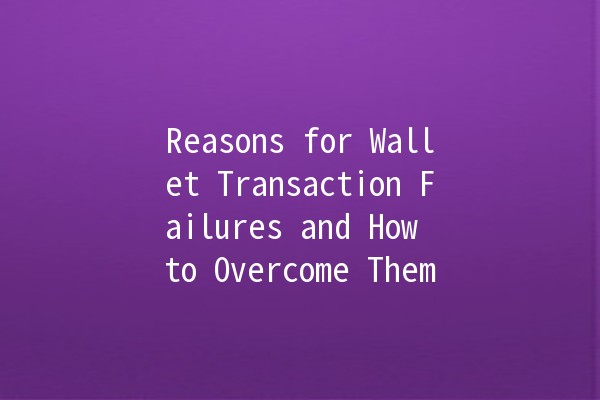
In today’s digital economy, the use of digital wallets has become increasingly popular for making transactions. However, encountering transaction failures can be frustrating and might even lead to financial loss. This article will explore various reasons wallet transactions could fail, offering practical tips to ensure smooth transactions moving forward.
Understanding Wallet Transactions

Digital wallets enable users to store payment information and make transactions seamlessly. They can be used for online shopping, transferring money to friends and family, or even instore purchases via contactless payments. But why do these transactions sometimes fail?
Common Reasons for Wallet Transaction Failures
One of the most common reasons for transaction failure is an insufficient balance in the wallet. Before attempting a transaction, always check your wallet’s balance to ensure you have enough funds to cover the payment.
Tip: Enable balance notifications or set automatic topups in your wallet settings to prevent this issue from arising.
A weak internet connection or server downtime can lead to failed transactions. If your device is not connected to a stable network, the transaction could timeout or fail altogether.
Tip: Always ensure you are connected to a reliable WiFi network or have a good mobile data connection before initiating a transaction.
Inputting incorrect information such as the recipient's wallet address, payment amount, or card details can lead to failure. Even minor discrepancies can cause a transaction to be rejected.
Tip: Doublecheck all entered information before confirming the transaction. This extra step can save time and reduce the chances of failure.
Using an outdated version of the wallet app can also hinder transaction success. App developers frequently update their apps to enhance security, fix bugs, and improve functionality.
Tip: Regularly check for updates in your app store and enable automatic updates if possible to stay current with the latest features and improvements.
Some banks impose restrictions on transactions made through digital wallets as a security measure. This might be due to unusual spending patterns, or the transaction being flagged as potentially fraudulent.
Tip: Contact your bank if you frequently encounter issues. They can provide insights into any restrictions that may be in place and help you adjust your account settings.
Transactions can fail if the payment method linked to the wallet has expired or has been declined. This includes expired debit or credit cards or accounts that have been temporarily suspended.
Tip: Keep your payment methods updated and regularly review your wallet settings to remove any obsolete accounts.
Wallet transactions may fail due to compliancerelated issues, such as not meeting KYC (Know Your Customer) regulations or restrictions based on geographic location.
Tip: Stay informed about the compliance requirements specific to your wallet and region. This knowledge can help you avoid unexpected transaction failures.
Productivity Enhancement Tips for Smooth Transactions
Use reminders on your phone or calendar to check your wallet balance weekly. This will help you avoid insufficient funds during important transactions.
Develop a checklist of essential steps to follow before making a digital transaction. This list should include checking your balance, ensuring a stable internet connection, and verifying payment details.
Familiarizing yourself with a wallet's features can significantly enhance your transaction experience. Spend time exploring your wallet app and understanding its functionalities, such as security settings or transaction tracking.
Establish a solid relationship with your financial institution. Regularly discuss any issues or changes with them to avoid unexpected hurdles related to your transactions.
Ensure your devices are updated, secure, and running smoothly. This includes clearing app caches, uninstalling unused apps, and updating your operating system to avoid conflicts that could impair wallet functionality.
Addressing Common Questions
Why Does My Wallet Transaction Keep Failing?
Repeated transaction failures could be due to several factors, including insufficient funds, incorrect payment details, or connectivity issues. Ensure you troubleshoot these possibilities each time you experience a failure.
How Can I Secure My Wallet Against Fraudulent Transactions?
To enhance the security of your wallet, enable twofactor authentication, regularly update your passwords, and avoid using public WiFi for transactions. These steps will minimize the risk of hacking.
Can Transaction Failures Be Reversed?
If a transaction fails, the funds typically remain in your wallet. However, if you suspect unauthorized transactions or a mistake, contact customer support for assistance to resolve the issue.
What Should I Do If My Wallet App Keeps Crashing?
If the app is crashing frequently, it is advisable to update the app, clear its cache, or reinstall it. If the problem persists, contact the app’s customer service for support.
Are There Fees Associated with Wallet Transactions?
Many digital wallets charge transaction fees, especially for currency conversions or international payments. Always check the fee structure in your wallet app to avoid unexpected costs.
How Can I Improve the Speed of My Wallet Transactions?
Ensure you are using a reliable internet connection, keep your app updated, and clear app caches regularly. These practices can help in reducing transaction processing times.
Understanding the common reasons behind wallet transaction failures can empower users to prevent these issues and enhance their overall digital transaction experience. By implementing the provided tips and staying informed, users can significantly reduce the frustration associated with failed transactions and enjoy a seamless experience with their digital wallets.
With meticulous attention to these facets, users can take control of their wallet transactions. Happy transactions!

